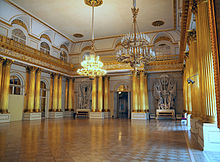Winter palace

Coordinates: 59 ° 56 ′ 26 ″ N , 30 ° 18 ′ 49 ″ E
The Winter Palace ( Russian Зи́мний дворе́ц [ ˈzʲimnʲɪj dvɐˈrʲɛts ]), also called the Winter Palace , was the main residence of the Russian tsars in Saint Petersburg . The building is located between the Palace Square and the banks of the Neva . Today it houses part of the Hermitage museum collection .
history
The name arose in contrast to the summer palace , which is located in the summer garden .
The first Winter Palace was built in 1711 and replaced by a new one in 1721, in which Tsar Peter I died. In the following years it was torn down and rebuilt by the builder Domenico Trezzini . Czarina Elisabeth had it torn down again due to a lack of imposing power and rebuilt from 1754 by Bartolomeo Francesco Rastrelli .
The Portraits of the Military Gallery (Военная галерея) was created between 1816 and 1826 and glorifies the Russian victory over Napoleon. Emperor Alexander I approved a list of generals submitted by the General Staff , whose portraits were to adorn the gallery. In 10 years of work, the British painter George Dawe and his Russian assistants Wassily Golike and Alexander Poljakov created 333 portraits, which are shown in five rows on the walls of the gallery.
On December 17th, Jul. / December 29, 1837 greg. the Winter Palace burned out completely in a 30-hour fire. Tsar Nicholas I ordered that the residence be restored to its previous state. At Easter 1839, the renovation work on and in the Winter Palace was completed. This was essentially the same as it is at this point today. The collection of paintings in the palace was only accessible to members of the narrow court circle. Nicholas I separated on February 5th July / February 17, 1852 greg. organisationally the Winter Palace and the Hermitage painting collection, which made the collection more public.
The Winter Palace got a tragic entry in the history books on January 9th July. / January 22, 1905 greg. , Petersburg Bloody Sunday , when Russian soldiers shot at the demonstrators in front of the Winter Palace during a march of demonstrating workers, killing hundreds. In 1906, Tsar Nicholas II read the first speech from the throne in front of the Duma in the Saint George Hall of the palace .
During the First World War , parts of the Winter Palace served as a hospital. Later it was the seat of the Provisional Government . The October Revolution experienced a decisive moment here when the Kerensky government was imprisoned by the Bolsheviks in the Winter Palace . After the revolution, the palace was attached to the neighboring Hermitage Museum and opened to the general public.
During the Great Patriotic War it was damaged during the Leningrad blockade between 1941 and 1944 and then restored. Today he is mainly affected by the large numbers of visitors, the lack of stability in the marshland and the moisture directly on the river. A renovation took place in 1984 and another in 2005.
Exterior construction
Rastrelli's building is considered one of the main works of the Russian Baroque . Four wings close in a rectangular shape around a large inner courtyard. Each side of the facade of the palace is decorated differently, the windows vary from floor to floor and from side to side. However, the three-storey structure, the abundant use of presented columns and the surrounding cornice band above the ground floor are uniform. The latter marks the separation of the level formerly assigned to the lower staff and the guards from the two upper floors reserved for the courtyard, which are combined on the facade with continuous columns (“monumental order”). On the balustrade of the roof and the gables there are vases and 3.50 meter high statues . The color of the building has changed over time and is still under discussion, currently (2016) a bluish green dominates.
Interior
For the collections see
Inside there are more than 1000 rooms. Hardly any interior furnishings have survived from the time before the fire in 1837.
The Jordan or messenger staircase leads from the north corner of the courtyard into the state rooms on the first floor. It was restored in its original form by Stassow after 1837. The “Small Throne Room” or St. Peter's Hall again corresponds to the plans of Auguste de Montferrand from 1833. The large Throne Room or St. George's Hall is in the state of being redesigned by Stassow. The largest room in the palace is the 1103 m² ballroom designed by Giacomo Quarenghi in 1793. The Malachite Hall (after 1837) takes its name from the columns and pilasters made from this material. It served as a salon for the wife of Nicholas I, Alexandra Feodorovna . Here and next door, in the “White Dining Room”, Kerensky's transitional government met for the last time in October 1917, until they were captured by the Bolsheviks in these rooms.
Web links
Individual evidence
- ↑ Images on Commons of the Malachite Hall
- ↑ Birgit Borowski: Baedeker St. Petersburg , 2014, pp. 143–146.




